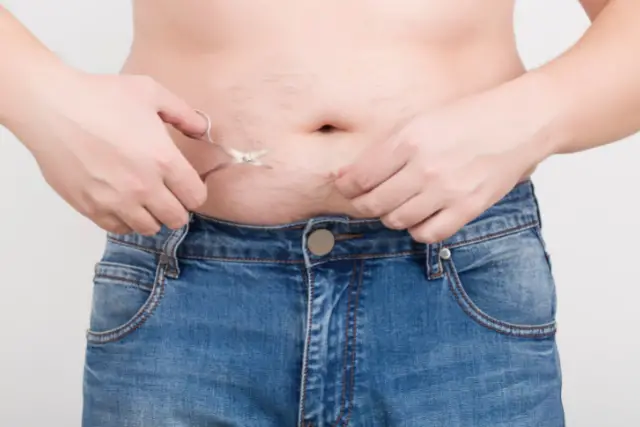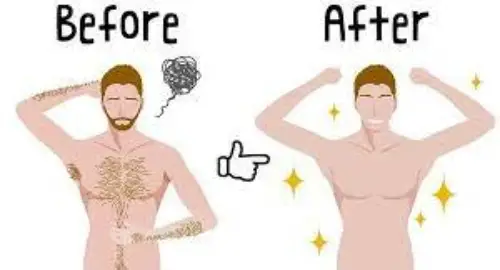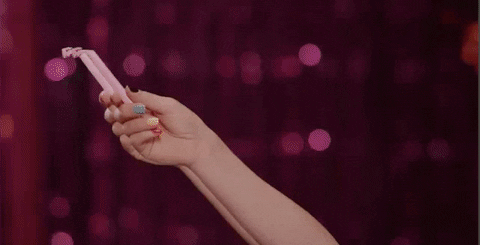Are you looking to take your grooming game up a notch? If you're aiming to boost your grooming routine, it's time to check out the realm of manscaping. Manscaping is all about maintaining and enhancing one’s appearance through strategic hair removal and proper hygiene practices.
Not sure where to start or what tools are necessary for successful results?
We've got you covered. Our comprehensive guide will give you all the tips and tricks needed on prepping your skin before manscaping, common mistakes made when attempting this delicate process, aftercare advice for optimal outcomes as well as an FAQ section with answers to some of the most popular questions around manscaping.
So read on—and get ready for an improved look that'll have heads turning in no time.
Page Contents
What is Manscaping?
Manscaping is the practice of trimming, shaving, and styling body hair for aesthetic purposes. It’s a popular trend among men who want to improve their appearance by grooming certain areas of their bodies. Manscaping can range from simply tidying up facial hair to completely removing all body hair.
Definition of Manscaping:
The term “manscaping” refers to the act of trimming or shaving body hair in order to achieve a desired look or style. This includes everything from shaping facial hair and eyebrows to waxing chest and back hairs, as well as trimming pubic hairs.
Benefits of Manscaping:
There are several benefits associated with manscaping including improved hygiene, increased confidence levels due to looking better, and reduced risk for skin irritation caused by excess body hair trapping sweat and bacteria against the skin.
Additionally, some people find that it helps them feel more comfortable in their own skin since they don’t have any unwanted or excessive amounts of body hair visible on their bodies.
Popular areas for manscaping include the face (eyebrows and beard), chest and back (waxing), underarms (shaving), groin area (trimming), and legs (shaving). Each area requires different tools depending on what you are trying to accomplish, such as razors for shaving versus trimmers for tidying up longer hairs.
It is essential to discern the optimal tool for your session prior to beginning in order to attain the desired outcome.
Manscaping is a critical component of any gentleman's grooming regimen, necessitating the appropriate equipment and techniques for a refined appearance that will bolster one's self-assurance. Now let's delve into the kind of equipment necessary to perfect your man-scaping.
Manscaping Tools
Your manscaping routine can involve anything from trimming facial and body hair to more drastic procedures like waxing, shaving or laser treatments. To get the best results when manscaping, it’s important to use the right tools for your skin type and grooming needs.
Tools for manscaping can range from the best ball shavers and electric trimmers to razors, scissors, tweezers, and even specialized creams/gels. Electric trimmers are great for larger areas like chest hair while razors work better on smaller patches like eyebrows or sideburns.
Scissors can be used to shape facial hair while tweezers are perfect for plucking stray hairs in sensitive areas like around the nose or ears. Specialized creams and gels can help reduce irritation caused by razor burns or ingrown hairs after a session has been completed.
When selecting the right tool for your needs, it is essential to consider factors such as skin sensitivity level, desired length of trimmed area (short stubble versus long beard), budget constraints (electric trimmers tend to be more expensive than manual ones), and ease-of-use (some tools require more skill than others).
If you have sensitive skin, an electric trimmer may be too harsh; thus, opt instead for a manual one with adjustable settings that will allow you to control how much pressure is applied during each stroke without causing any discomfort or irritation.
When handling any tool, caution should be taken to not put too much pressure as this could lead to abrasions and lacerations that can become infected if left untreated.
Always clean your tools before use with warm water and soap or disinfectant spray in order to prevent bacteria build-up which could also lead to infection over time if left unchecked. Additionally, always read all instructions carefully before use in order to ensure optimal results every time.
Manscaping is an important part of any man’s grooming routine. It can help you look and feel your best, as well as boost your confidence.
Read Also: How to Manscape

But it’s not always easy to know what tools are needed for manscaping or how to use them properly. That’s why we’ve put together this guide on the different types of tools needed for manscaping, how to choose the right tool for your needs, and tips for using the right tool for your skin type.
Manscaping requires an array of tools, ranging from electric razors to trimmers and scissors for precise trimming, plus clippers and tweezers for more intricate details. Electric shavers offer a convenient way to get a close shave without the risk of nicks or cuts from using blades.
Trimmers are perfect if you need precision trimming around edges like sideburns or goatees. Scissors can be used to snip away stray hairs with ease while clippers provide quick results when cutting large areas such as chest hair or back hair.
Finally, tweezers come in handy when dealing with ingrown hairs or other unwanted facial hair growth that may require more precise removal than shaving alone provides.
When selecting the right tool for your needs, it is essential to take into account factors such as skin sensitivity level and desired outcome. If you have sensitive skin, an electric razor might be more suitable since blades can cause irritation.
However, if you are looking for more control over length then trimmers may provide better results due to their ability to allow users greater control of how much hair gets cut off each time they use it. Compared to electric razors which generally trim everything down evenly regardless of the length setting chosen by the user prior to beginning their session.
Depending on your skin type, there are certain considerations to take into account before beginning any manscape session. For example, those with sensitive skin should avoid products containing alcohol as this can dry out the skin further and exacerbate existing issues.
Additionally, those with oily complexions should opt for water-based products instead of oil-based ones in order to avoid stripping away natural oils produced by the body which could leave behind unhealthy residue after completion.
When it comes to manscaping, having the right tools is essential for achieving desired results. With proper preparation and knowledge of the various tools available, you can make sure that your next manscaping session is comfortable and successful. Now let's look at how to prep your skin before beginning a manscaping session.
Prepping Your Skin Before Manscaping
Before you start manscaping, it’s important to properly prepare your skin. Taking the time to do this can help ensure maximum comfort and results during a session. Here are some steps you should take before starting:
Cleanse Your Skin:
Start by cleansing your skin with warm water and a gentle cleanser or scrub. This will remove any dirt, oil, sweat, or other debris that could cause irritation while shaving. Make sure to rinse thoroughly afterward and pat dry with a clean towel.
Exfoliate:
Exfoliating is an important step in prepping for manscaping as it helps remove dead skin cells from the surface of your skin which can clog up razor blades and lead to ingrown hairs or irritation when shaving.
Use an exfoliating scrub designed specifically for men's grooming needs like one containing natural ingredients such as sea salt or sugar crystals that won't be too harsh on the skin but still provide effective exfoliation benefits.
Before shaving, slather on some pre-shave oil to make facial hair more pliable and manageable for the razor blade, thus avoiding irritation or cuts. Look for oils formulated specifically for men's grooming needs like those containing jojoba oil which is known for its moisturizing properties that help keep skin hydrated throughout a shave session.
Moisturizing after each shave session is essential in order to keep your face looking healthy and smooth post-shave. Opt for a lightweight moisturizer designed specifically for men's grooming needs, such as one containing aloe vera extract which helps soothe irritated areas while providing long-lasting hydration benefits.
Preparing your skin properly before a manscaping session is essential for achieving the best results, so be sure to follow these steps and tips to ensure you have an optimal experience. Now let's move on to aftercare tips that will help you maintain those results.
Aftercare Tips for Optimal Results from Manscaping
After a manscaping session, it is important to take the necessary steps to ensure optimal results. The first step should be to cleanse the area with warm water and antibacterial soap or cleanser. This will help remove any bacteria that may have been introduced during the session and prevent infection.
Once the area has been cleansed, pat it dry with a soft cloth and apply an aftershave balm or moisturizer to provide soothing relief and keep the skin hydrated. Avoiding the utilization of hot water on freshly shaved areas is critical, for it can cause irritation and further harm the skin.
It is essential for keeping your skin healthy after a manscaping session by applying lotion or oil regularly throughout the day. This will help lock in moisture, reduce inflammation, and protect against razor burns or ingrown hairs caused by friction from clothing.
Additionally, you should exfoliate once every week using a gentle scrub designed specifically for men's grooming needs such as those containing salicylic acid which helps unclog pores of dirt buildup while removing dead skin cells at the same time.
With the right aftercare, you can ensure that your manscaping session yields the best results possible. But it's also important to be aware of common mistakes made when starting out with this practice and how to avoid them in order to get the most out of your sessions.
Let's explore some of the most common missteps to be aware of when beginning manscaping, so you can make the most out of your sessions.
Common Mistakes Made When Manscaping
Manscaping is a popular grooming practice among men of all ages. Yet, attaining the preferred outcome sans committing typical missteps can be a tricky feat. To get the best out of manscaping, here are some pointers to help evade common pitfalls.
People starting out with manscaping often overlook the importance of adequately prepping their skin before beginning, which can result in undesirable consequences such as inflammation, ingrown hairs, and other difficulties that could have been avoided by taking the necessary precautions.
Not prepping your skin before a session can lead to irritation, ingrown hairs, and other issues that could have been avoided if proper steps were taken beforehand. Another mistake people often make is using tools that are too harsh or abrasive for their skin type which can cause further damage and discomfort during a session.
Prior to beginning any manscaping session, it is essential to take the time necessary to adequately prepping your skin by exfoliating gently and moisturizing thoroughly. This will help guarantee maximum comfort during the process as well as better results afterward.
Furthermore, it is critical to select tools that are specifically intended for delicate areas such as those found around the groin area; these may include trimmers designed exclusively for this purpose or electric razors with adjustable settings in order to avoid cutting oneself or causing unnecessary irritation while striving towards desired outcomes.
Frequently Asked Questions
What is the purpose of manscaping?
Manscaping includes tidying up the chest, back, legs, arms, face, and pubic region by either shaving or waxing. The purpose of manscaping is to improve a man's appearance by creating a neat and clean look that emphasizes his best features.
Manscaping also helps reduce body odor caused by bacteria trapped in excess body hair. In addition to improving physical appearance, manscaping can help boost confidence levels and make it easier for men to feel comfortable with their bodies.
How do you manscape your pubic area?
Manscaping your pubic area is an important part of any grooming routine. It's best to start by trimming the hair with a pair of scissors or an electric trimmer, then using a razor for more precise shaping.
Be sure to use sharp blades and shaving cream to avoid irritation and ingrown hairs. When finished, apply an aftershave balm or lotion to soothe the skin and reduce redness. Finally, keep it clean by washing regularly with warm water and mild soap.
With correct maintenance and consideration, you can accomplish a flawless look that will make you feel fantastic.
Do ladies like manscaping?
Manscaping is a personal choice, and opinions vary. Some ladies may find it attractive while others may not. Some ladies may also be wondering if men should remove their pubic hair. Ultimately, it's up to the individual man to decide what he feels comfortable with and how he wants to present himself.
It's really a matter of individual choice; there isn't any definite "yes" or "no" when it comes to manscaping. Everyone has different preferences when it comes to grooming, so ultimately it boils down to personal preference.
Is it healthy to shave a male's pubic hair?
No, it is not healthy to shave pubic hair. Shaving can cause irritation and leave the skin vulnerable to infection. Shaving can lead to painful and unattractive ingrown hairs, making it best to steer clear of trimming the pubic area.
Additionally, shaving does not offer any health advantages; in fact, pubic hair is a key factor for protection against possible bacteria and other pathogens that could potentially penetrate the body through tiny cuts or abrasions. For these causes, abstaining from shaving your pubic hair may be the preferable choice.
Conclusion
Manscaping is a great way to improve your look and feel more confident. With the right tools, prepping techniques, and aftercare tips you can achieve optimal results from manscaping. Just remember to avoid common mistakes like using too much pressure or not taking proper care of your skin afterward.
With these tips in mind, you'll be able to master the art of manscaping with ease.



